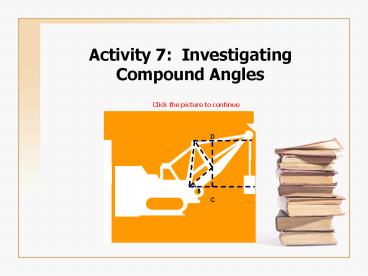Activity 7: Investigating Compound Angles PowerPoint PPT Presentation
Title: Activity 7: Investigating Compound Angles
1
Activity 7 Investigating Compound Angles
Click the picture to continue
2
Activity 7 Investigating Compound Angles
- In the introduction of the activity, we conclude
that the best way to find the exact value of
sin75o was to write is as a sum of two angles
- We know that
- So, if then,
3
Activity 7 Investigating Compound Angles
- When we try to get an approximate value on the
calculator we get
- Why do we get two different answers?
- We have to graph this angle in standard position
to verify which answer is correct.
4
Activity 7 Investigating Compound Angles
- Let us place this angle in standard form where
radius is 1
We can solve for this right triangle since we
have our angle, p/6 and the hypotenuse of
1.
Given the angles in the smallest right triangle,
it is now possible to calculate the
altitude.
We use the cosine ratio cos(p/4)AD/HY cos(p/4)A
ltitude/sin(p/6) Altitudesin(p/6)cos(p/4)
Therefore, sin(75o)sin(p/6 p/4) sin(p/6)cos(p/4)
sin(p/4)cos(p/6) When we calculate this using
special angles 0.966 This is the answer we
got on the calculator
Split the angle into radian angles of p/6 p/4.
This is the same as 45o and 30o. The angle is
now a compound angle.
Since we are trying to find the ratio sin(p/6
p/4), we should identify the sides we need in
order to solve this ratio. sin(angle)OP/HY.
We are now going to create a right triangle
inside the p/6 compound angle where the right
angle start on the end of the green arrow.
The altitude of the right triangle created with
the angle p/4 can be solved since its hypotenuse
is cos(p/6).
To solve for the second altitude we must find the
angle denoted by the blue dot
Using simple geometry and creating a pair of
parallel lines we see that the blue dot and the
red dot must sum up to 90o. Based on alternate
angles, the blue dot must be equal to p/4
rads.
HYPOTENUSE
p/4
sin(p/6)
sin(p/6)cos(p/4)
OPPOSITE
1
cos(p/6)
p/6
ß
sin(p/4)cos(p/6)
75o
p/4
5
Activity 7 Investigating Compound Angles
- In general, when finding the sine ratio of a
compound angle as shown belowsin(AB)
sinAcosB sinBcosA
sinAcosBsinBcosA
A
B
6
Activity 7 Investigating Compound Angles
- Go back to the activity website and complete the
rest of the activity online!
PowerShow.com is a leading presentation sharing website. It has millions of presentations already uploaded and available with 1,000s more being uploaded by its users every day. Whatever your area of interest, here you’ll be able to find and view presentations you’ll love and possibly download. And, best of all, it is completely free and easy to use.
You might even have a presentation you’d like to share with others. If so, just upload it to PowerShow.com. We’ll convert it to an HTML5 slideshow that includes all the media types you’ve already added: audio, video, music, pictures, animations and transition effects. Then you can share it with your target audience as well as PowerShow.com’s millions of monthly visitors. And, again, it’s all free.
About the Developers
PowerShow.com is brought to you by CrystalGraphics, the award-winning developer and market-leading publisher of rich-media enhancement products for presentations. Our product offerings include millions of PowerPoint templates, diagrams, animated 3D characters and more.

